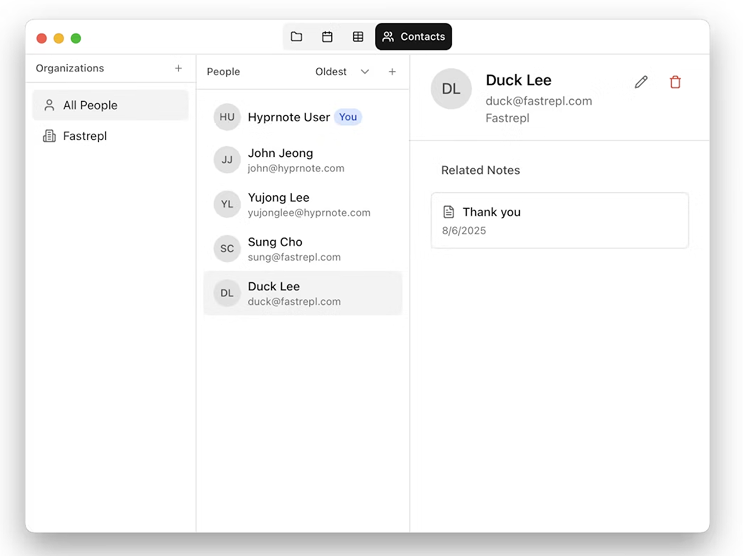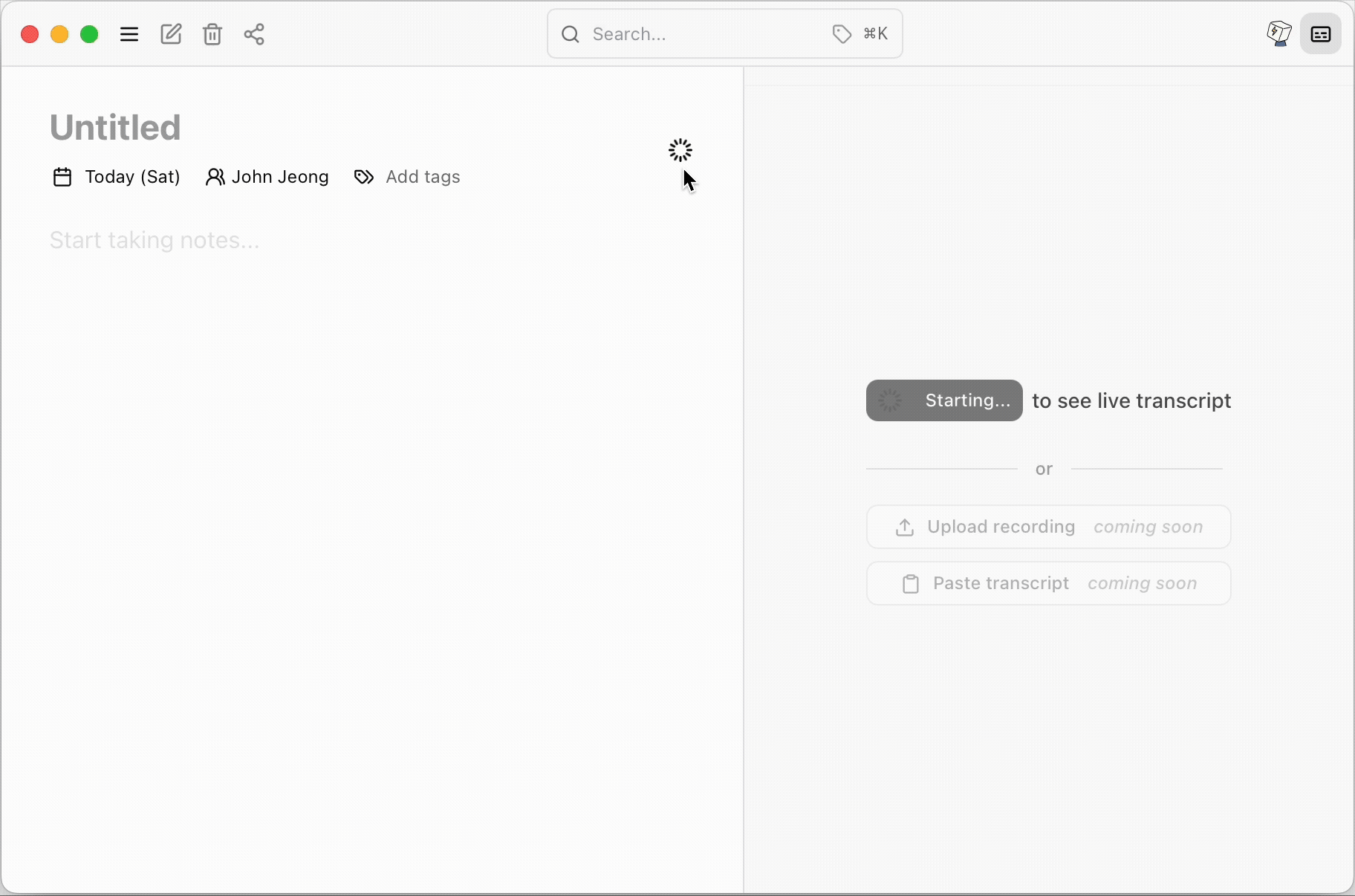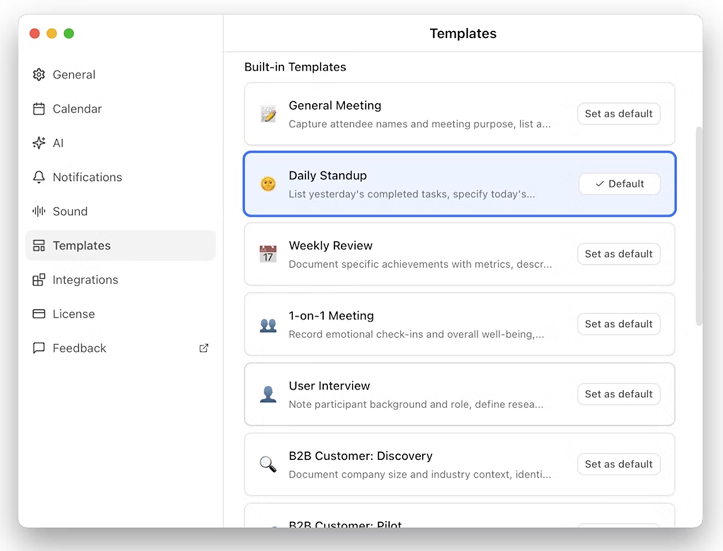Walk into your next meeting with clarity instead of chaos. This checklist walks through the preparation steps that reduce meeting fatigue and help you run focused, effective meetings.
Stop Scrambling Before Calls with This Meeting Preparation Checklist
1. Context Mining: Review Past Conversations and Unresolved Items
Before walking into any meeting, you need to know what's already been said. Not just the official minutes, but the actual conversations, the decisions made, the action items that fell through the cracks.
This is where most people fail. They show up with a vague memory of "we discussed this before" but can't recall the specifics. Who said what? What was decided? What got left unresolved?
The manual approach is brutal: digging through old emails, Slack threads, and scattered notes trying to piece together context. It takes hours and you still miss things.
A better system 💡: Use an AI notetaker that lets you search across all past conversations instantly. With Hyprnote's Search feature, press cmd + k and type any keyword: a project name, a person, a specific topic. You'll see every note containing that term, along with when it was mentioned and who said it.

Need deeper insight? Open AI Chat for any past meeting and ask questions like "What did Sarah say about the budget constraints?" or "Bring up notes related to the product launch timeline." The AI pulls exact context from transcripts so you're not working from memory.
This matters because walking into a meeting armed with specific references shows preparation and keeps conversations focused on moving forward, not rehashing what's already been covered.
2. Stakeholder Research & Profiling: Know Who You're Talking To
Generic meeting prep treats all participants the same. Strategic prep recognizes that every person brings different priorities, communication styles, and decision-making authority.
Before the meeting, research each participant:
- Professional background: What's their role? What projects are they currently focused on? What's their expertise?
- Communication style: Do they prefer data and analytics, or stories and examples? Do they ask lots of questions or prefer to listen first?
- Decision-making authority: Can this person say yes, or do they need to escalate? Who influences their thinking?
- Recent context: What wins or setbacks have they experienced lately that might affect their perspective?
This research serves double duty.
First, it helps you tailor your communication approach.
Second, it helps you anticipate conflicts before they surface.
When you know that two participants have historically disagreed on resource allocation, or that the legal team has concerns about compliance implications, you can proactively address these tensions in your preparation rather than getting blindsided mid-meeting.
Where to gather this intel 💡: LinkedIn for professional background, your CRM for past interactions, and your meeting history.

If you use Hyprnote, check the Contacts View in Finder to see every meeting you've had with each person, what they care about, and where previous conversations left off. Filter contacts by organization to understand team dynamics and spot patterns in what resonates with that company.
3. Sending the Briefing Package and Meeting Details
Send a briefing package 24-48 hours before the meeting. When participants show up informed, you skip the "let me catch everyone up" phase and jump straight into productive discussion.
Here's what to include:
- Meeting logistics: Date, time, duration, platform (with login details for virtual meetings), physical location with map link if in-person
- Clear meeting objective: One sentence stating exactly what you need to accomplish. "Decide on Q2 marketing budget allocation" is clear. "Discuss marketing stuff" is not.
- Meeting agenda: Specific topics, time allocations, and who's leading each discussion point
- Pre-reading materials: Background documents, relevant data, context from previous meetings. Keep these concise; nobody reads 40-page reports.
- Preparation expectations: Be explicit. "Please review the budget scenarios and come prepared with your preference" tells people what to actually do.
- Decision framework: If you're making decisions, explain how. Consensus? Voting? Executive call? When people know the rules upfront, meetings run faster.
- Recording notice: If you're recording (and if you're using Hyprnote), mention it in the invite. Transparency builds trust, especially in compliance-sensitive industries.
Pro tip 💡: Don't bury this in a massive email thread. Create a single source of truth: a shared doc, a sales room, a project page, and link to it clearly in the calendar invite.
Talk to the founders
Drowning in back-to-back meetings? In 20 minutes, we'll show you how to take control of your notes and reclaim hours each week.
Book a call4. Participation Strategy: Design for Diverse Voices
The loudest voices dominate meetings by default. Without a deliberate participation strategy, you'll hear from the same three people while everyone else checks out.
Here's how to fix that:
Round-robin for key decisions: When you need input on important decisions, explicitly go around the (virtual) table. "Let's hear from everyone on this. Maya, would you start us off?" This ensures quieter team members don't get talked over.
Parking lot for tangents: Create a "parking lot" list visible to everyone (a shared doc, whiteboard, or just someone taking notes). When important but off-topic items come up, acknowledge them: "That's worth discussing, let's add it to the parking lot and schedule time for it." This keeps the current meeting focused without dismissing valid concerns.
Structured Q&A segments: Instead of "any questions?" which usually gets silence, try "I'm going to pause here for questions, please drop them in chat or unmute." Or assign specific Q&A windows: "After the budget overview, we'll have 10 minutes for questions about resource allocation."
Pre-assign speaking roles: If you need input from specific people, tell them before the meeting. "Dev, I'd like you to speak to the technical feasibility. Priya, can you cover the customer impact?" People contribute better when they know they're expected to speak and have time to prepare.
This isn't about running a democracy for every minor point. It's about making sure you actually hear the perspectives that matter before making decisions.
5. Fallback Plans: Prepare for When Discussions Stall
Even well-planned meetings hit roadblocks. A key stakeholder is missing. The group can't reach consensus. The discussion reveals new information that changes everything.
Without fallback plans, these moments derail the entire meeting. With them, you pivot smoothly and still make progress.
Prepare for these contingencies:
If consensus fails: Have a tiebreaker mechanism ready. "If we can't reach agreement today, [person] will make the final call by Friday." Or: "We'll test both approaches for two weeks and decide based on data."
If key information is missing: Don't fake it. Acknowledge the gap: "We need the cost estimates before deciding. Let's table this specific decision, finalize the other items, and reconvene on Thursday." Have a clear process for who's getting what information by when.
If a participant is absent: For critical attendees, either reschedule (if their input is truly essential) or have an asynchronous way for them to contribute. "We'll proceed with the discussion, record it, and get Jamie's input before finalizing tomorrow."
If discussion reveals unexpected complexity: Recognize when you're in over your head. "This is clearly more involved than we thought. Let's spend the remaining time identifying what we need to research, assign owners, and schedule a follow-up next week."
If conflict escalates: Have a pressure release valve. "I can see we have strong perspectives on this. Let's take a 10-minute break to reset." Or redirect: "Let's document both viewpoints and their rationale, then revisit this after we've had time to reflect."
The goal isn't to predict every possible scenario. It's to think one step ahead so when something goes sideways, you're steering the meeting back on track instead of watching it crash.
6. Meeting Recording: Capture Everything Without the Overhead
Here's the problem with meeting documentation: traditional methods either miss crucial details or require so much effort that nobody maintains them.
Taking manual notes means you're distracted from the actual conversation. Missing the recording means you lose context. Inviting a bot to your call announces to everyone that their words are being sent to the cloud—not ideal for sensitive discussions.
The modern approach: local, automatic recording
Hyprnote solves this by running entirely on your device. No bot joins your call. No data leaves your machine. It just captures the conversation, both your microphone and system audio, so you have a complete record without the overhead.

What to consider when recording 💡:
- Consent management: In many jurisdictions and industries, you need explicit consent to record conversations. Mention recording in your meeting invite. For higher-stakes meetings, consider verbal confirmation at the start: "Just confirming we're recording this for our records, everyone comfortable with that?"
- For compliance-sensitive industries (healthcare, legal, finance), local-first recording like Hyprnote provides is often the only compliant option. When you're discussing patient information, legal matters, or confidential business details, keeping everything on-device helps you meet HIPAA, attorney-client privilege, and other regulatory requirements.
- Environment matters: Find a quiet space. Use a decent microphone. Background noise and poor audio quality break transcription accuracy.
- Offline meetings: If you're recording an in-person conversation, make sure your meeting assistant doesn't ditch you when you need it most. Choose tools that don't rely on internet connectivity for transcription and note-taking. Hyprnote runs entirely on your device using local AI models, so it works in basement conference rooms, on planes, or anywhere without WiFi.
7. Meeting Templates: Stop Starting from Scratch Every Time
You run the same types of meetings repeatedly. Customer calls. Team standups. Strategy reviews. Performance check-ins. Why are you rebuilding the structure from scratch each time?
Templates reduce cognitive load by giving you a proven framework. Your brain can focus on the actual conversation instead of the meta-work of designing the conversation.
How to create meeting templates:
Identify your recurring meeting types. For each, define the standard structure. Customer discovery might be: context questions (10 min), pain points (15 min), solution exploration (15 min), next steps (5 min). Weekly team updates might be: wins, blockers, priorities, action items.
The power move: Hyprnote lets you create custom templates that automatically structure your AI-generated summaries.
Set a default template in Settings, and every meeting gets summarized in that format automatically. Or select a specific template right after finishing a recording for one-off meetings.

To create a custom template, define your sections (the structure you want) and add system instructions (rules for the AI to follow). For example:
- For user interviews: "For every bullet point you write, attach the user's actual quote as a reference next to it." Now every interview summary comes with supporting evidence automatically.
- For sales calls: "Generate the summary in JSON format with fields: painPoints, budget, timeline, decisionMakers." Perfect if you're pushing data to a CRM.
- For therapy or coaching sessions: "Focus on the client's own words and emotional themes. Minimize interpretation."
The more specific your instructions, the better the AI tailors notes to your needs.
So, there you have it—seven steps that transform chaotic meeting prep into a structured process.
Use Hyprnote for Productive Meetings
Meeting preparation is mentally exhausting when you're doing it all manually: searching through old emails, reconstructing context from memory, frantically taking notes while trying to stay present in the conversation.
Hyprnote was built to eliminate that overhead.
Before the meeting: Use Search (cmd + k) to instantly find relevant past conversations. Check Contacts View to see your complete history with each participant. Ask AI Chat questions like "What did we decide about the pricing model?" to pull specific context without digging through transcripts.
During the meeting: Stop trying to be a human tape recorder. Hyprnote captures everything automatically—both what's said and what you're thinking—all running locally on your device. Your data never leaves your machine, making it the only compliant option for sensitive conversations in healthcare, legal, and finance. You can stay fully present in the conversation instead of splitting focus between listening and documenting.
After the meeting: You don't need to immediately process anything. Take an actual break. When you're ready, your AI-generated summary is waiting with your custom template already applied. Hover over any part to see the exact quote from the transcript. Ask AI Chat "What are my action items?" instead of hunting through notes. Search across all meetings to track themes and patterns.
This way, you spend your mental energy on thinking, not on reconstructing what happened or organizing information. That's what AI is for.
Download Hyprnote free and have productive meetings with confidence
Talk to the founders
Drowning in back-to-back meetings? In 20 minutes, we'll show you how to take control of your notes and reclaim hours each week.
Book a call